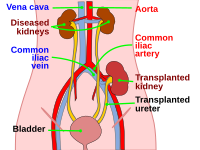
Photo from wikipedia
Purpose: To evaluate the outcomes of percutaneous intervention (PI) for transplant renal artery stenosis (TRAS). Materials and Methods: Doppler ultrasonography was used as the screening tool, and angiography was the… Click to show full abstract
Purpose: To evaluate the outcomes of percutaneous intervention (PI) for transplant renal artery stenosis (TRAS). Materials and Methods: Doppler ultrasonography was used as the screening tool, and angiography was the diagnostic method for TRAS. The indications for PI were (1) a reduction in lumen diameter of >50% or (2) a mean pressure gradient of >15 mm Hg. Technical success was assessed immediately after the procedure. The short-term results of stenosis were evaluated by serum creatinine (Scr) levels and blood pressure (BP). The long-term results were assessed by graft survival and renal function. Results: From October 2009 to July 2015, a total of 660 patients had kidney transplantation and 22 cases underwent PI. The technical success was 100%. The mean Scr level preintervention was 321.6 ± 167.2 (range, 171.3-862.0) μmol/L, and it decreased to 145.3 ± 44.7 (range, 74.3-260.8) μmol/L 1 month postintervention (P < .001). Blood pressure was also improved at 1 month postintervention, as assessed by systolic (157.0 ± 13.0 vs 131.0 ± 11.0 mm Hg, P < .001), diastolic (95.0 ± 5.0 vs 77.0 ± 9.0 mm Hg, P < .001), and mean arterial pressure (116.0 ± 7.0 vs 95.0 ± 9.0 mm Hg, P < .001). The patency rate was 100%, 91.7%, and 85.7% at 1, 3, and 12 months, respectively. The secondary patency rate was 100%. Graft survival was 100% during follow-up. There was no significant deterioration in graft function or BP (P > .05) postintervention when compared to posttransplantation. Conclusions: Percutaneous intervention for TRAS is safe and results in significant improvement both in allograft function and in BP.
Journal Title: Vascular and Endovascular Surgery
Year Published: 2017
Link to full text (if available)
Share on Social Media: Sign Up to like & get
recommendations!